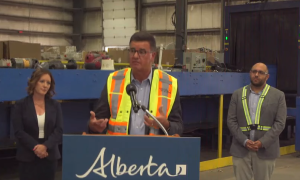
The province’s four-year pilot program will become permanent on April 1. | Butenkov Aleksei/Shutterstock
Canada’s oldest provincial electronics recycling program will add more than 500 device types to its accepted materials list, making permanent a pilot program that’s been under way for four years.
Alberta, Canada’s fourth-largest province with more than 4.8 million residents, on Aug. 13 announced a series of significant changes to its electronics recycling program, set to take effect next year. They’ll bring almost all types of consumer devices into the program and will lay the groundwork for the first provincial management program covering renewable energy-linked materials, including solar panels, electric vehicle batteries and wind turbine blades.
Managed by the Alberta Recycling Management Authority, the program has been running since 2004. Historically, ARMA accepted a smaller list of devices, primarily computer equipment and various generations of TV technology, including CRTs and LCD displays.
In 2020, the stewardship group announced that an expanded list of devices would be accepted during a two-year trial run. Totaling more than 500 individual device types, the program brought in broad categories like mobile devices, audiovisual devices such as VCRs and DVD players, video game equipment, electric music instruments, power tools, small appliances, lawn equipment and toys.
After the first two years, the program had brought in about 10,000 metric tons of additional equipment that wouldn’t otherwise have been accepted, Ed Gugenheimer, ARMA’s CEO, told E-Scrap News this week.

Ed Gugenheimer, CEO of ARMA, speaks alongside Rebecca Schulz, Alberta’s Minister of Environment and Protected Areas, and Gary Diamond, president of ITAD giant Quantum Lifecycle Partners, at a Quantum facility last week. | Photo from YouTube
The pilot was extended for another two years, during which about 11,000 metric tons of those additional device types were collected, Gugenheimer said.
The results were appreciated by ARMA, the e-scrap processors it works with and government officials alike. During a press conference staged at a Quantum Lifecycle Partners facility in Edmonton last week, Rebecca Schulz, Alberta’s Minister of Environment and Protected Areas, called the four-year trial run “a huge success.”
“It’s seen recycling facilities like the one that we are visiting here today, scale up their workforce and their tech to be able to recycle electronics of all shapes and all sizes,” Schulz said.
The expanded material list becomes permanent on April 1, 2025. As it has for years, the program will be funded through fees added at the point of sale on covered devices.
Gugenheimer said the existing program list material — not including the pilot materials — currently totals about 8,500 metric tons per year, and ARMA estimates roughly 3,000 to 3,500 metric tons of newly accepted devices will come in per year after the program becomes permanent. It’s hard to estimate what will come in on a regular basis, though, because during the pilot program ARMA saw a number of stockpiles of newly covered devices being collected: Groups that didn’t want to landfill those devices had amassed them until a solution was available, he noted.
ARMA supports processors through investment
Quantum Lifecycle Partners, a major processor that has repeatedly expanded in Canada during the last few years, is one of six processors registered to process material collected through the ARMA program. That makes the company, which has participated since the provincial program began, eligible to receive investment funds from ARMA.
Along with the device type expansion announcement, ARMA announced it is investing $250,000 Canadian ($184,000 U.S.) in matching grant funds for equipment to be installed at Quantum’s Edmonton facility.
The money will facilitate installation of “an x-ray sorting machine that has artificial intelligence, that helps us identify items containing batteries and other hazards,” said Gary Diamond, president of Quantum, during last week’s news conference.
He described how many electronic items have embedded batteries, which present a persistent threat of thermal events at recycling centers.
“It’s really difficult to identify these items,” he said. “We also don’t want to shred these items, because they can cause fires, and that’s really bad for our employees.”
E-Scrap News has covered the emerging x-ray battery-identification technology multiple times in recent months.
Recycling renewable energy devices
As part of the expansion, ARMA announced it is in the early stages of developing a similar provincial recycling program to cover solar panels, electric vehicle batteries and wind turbine blades.
These materials, which are essential to generating and delivering clean energy, are increasingly ending up in the end-of-life material stream. And although EV battery recycling infrastructure is ramping up and there have been forays into the solar panel and wind turbine recycling sectors, this would mark the first Canadian stewardship program for such materials.
Gugenheimer said ARMA received a number of inquiries from collection sites about the possibility of adding solar panels and other renewable energy devices. Some initial research into the prospect was done during the pilot, and now the provincial government is leading a consultation to figure out what such a program could look like. Regulators are considering policy tools, like a landfill ban on solar panels, for example, and are looking at how to facilitate solar panel reuse.
All that’s to say, the program is going to take time to develop. It will launch later than the other program expansions, Gugenheimer said, but the groundwork is under way. He said solar panels will probably be the first of the renewable device materials to come into a stewardship program.
“I think it’s a challenge, and you’ve got to figure it out,” Gugenheimer said. “It’s a puzzle, no one’s done it before, and that’s part of the excitement of what we’re doing.”

